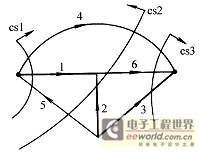For the same circuit, if the numbers and directions of the branches and nodes are the same, there is a certain connection between the correlation matrix, loop matrix and cut set matrix written out.
For the directed graph shown in Figure 7-5-1, select branches 1, 2, and 3 as branches, and make single branch cut sets as shown in the figure. Then, its basic circuit matrix and basic cut set matrix can be written as follows:


Figure 7-5-1
Multiplying
by
on the left
gives:
![]()
![]()

That is:
![]() (7-5-1)
(7-5-1)
According to the matrix properties, another form can be obtained:
![]() (7-5-2)
(7-5-2)
These two equations reflect
the relationship between
the basic cut set matrix
and the basic loop matrix
in the network with the same number.
![]()
![]()
The general proof of formula 7-5-1 can be briefly described as follows: Let
, then
any element in
D
is
, the subscript
j
represents the
jth
single-branch loop,
k
represents the
kth
cut set, and
represents the
multiplication of the
i-
branch element
in
the
j-th
loop
and
the
i-
branch element
in
the
k-th
cut set
. Obviously, if
the
i-
branch is not included in both
the j
-loop and
the k
-cut set, the product must be zero.
The number of branches
included in both the
j
-loop and
the k-
cut set must be an even number. Because if all the branches in
the k
-cut set are removed, the circuit is divided into two independent parts. If a closed loop spans two parts of the circuit, it is obvious that the number of branches connecting the two parts (included in
the
k-
cut set) must be an even number. For example, for the network shown in Figure 7-5-1, the number of branches included in both cut set 1 and loop 1 (a single-branch loop composed of branch 4) is 4 and 1.
![]()
![]()
![]()
![]()
![]()
For branches that appear in pairs in the loop and the cut set, if the directions of the two branches are consistent with the loop (in this
case, the two elements in the corresponding row
have the same sign), then the two branches must have one positive and one negative direction with the cut set (in this
case,
the two elements in the corresponding row
have different signs), and
the value of must be zero. Conversely, if the directions of the two branches are one positive and one negative direction with the loop, then they must have the same sign relative to the cut set direction, and their product is
also zero. It can be seen that the elements in the matrix
D
are all zero, so formula (7-5-1) can be derived.
![]()
![]()
![]()
![]()
![]()
![]()
If the network branch numbering is strictly arranged in the order of tree branch first and then link branch, then formula (7-5-1) can be written as:
![]()
That is:
![]() (7-5-3)
(7-5-3)
Where,
represents the loop matrix submatrix composed of tree branches;
represents the cut set matrix submatrix composed of connected branches.
![]()
![]()
For the circuit in Figure 7-5-1, if node 4 is set as the reference node, its association matrix is written as:

Multiplying
A
on the left
gives:
![]()

That is:
![]() (7-5-4) or
(7-5-5)
(7-5-4) or
(7-5-5)
![]()
In fact, if the cut set is selected to surround only one node, and the cut set direction leaves the node, then the cut set formed in this way is the association matrix A , which means that the association matrix is nothing more than a form of the cut set matrix. From formula (7-5-1), it can be seen that formula (7-5-4) is established.
If the branch numbering is done by tree branch first and then connected branch, the association matrix can be expressed as
, where
represents the submatrix composed of all tree branch elements, and
represents the submatrix composed of connected branch elements. Formula (7-5-4) can be described as:
![]()

![]()
![]()
Multiply the above formula on the left
to get:
![]()
![]()
That is:
![]() (7-5-6)
(7-5-6)
Based on this, the basic loop matrix can be written as:
![]() (7-5-7)
(7-5-7)
From this expression, it can be seen that for a circuit whose branch numbering adopts the method of first tree branch and then connecting branches, its basic loop matrix
can be obtained through the correlation matrix.
![]()
Similarly, from equations (7-5-3) and (7-5-6), we can get,
, so the basic cut set matrix can be expressed as:
(7-5-8)
![]()
![]()
It can be seen from the formula that the basic cut set matrix can be obtained from the incidence matrix.
When using computer-aided calculation to establish state equations, it is often difficult to directly write the loop matrix or cut set matrix, but it is very convenient to derive the association matrix. Therefore, in practical applications, the loop matrix and cut set matrix are often obtained from the association matrix through equations (7-5-7) and (7-5-8).
Previous article:Nodal voltage equations in matrix form
Next article:Loop Matrix and Loop Voltage Law
- Popular Resources
- Popular amplifiers
- High signal-to-noise ratio MEMS microphone drives artificial intelligence interaction
- Advantages of using a differential-to-single-ended RF amplifier in a transmit signal chain design
- ON Semiconductor CEO Appears at Munich Electronica Show and Launches Treo Platform
- ON Semiconductor Launches Industry-Leading Analog and Mixed-Signal Platform
- Analog Devices ADAQ7767-1 μModule DAQ Solution for Rapid Development of Precision Data Acquisition Systems Now Available at Mouser
- Domestic high-precision, high-speed ADC chips are on the rise
- Microcontrollers that combine Hi-Fi, intelligence and USB multi-channel features – ushering in a new era of digital audio
- Using capacitive PGA, Naxin Micro launches high-precision multi-channel 24/16-bit Δ-Σ ADC
- Fully Differential Amplifier Provides High Voltage, Low Noise Signals for Precision Data Acquisition Signal Chain
- Innolux's intelligent steer-by-wire solution makes cars smarter and safer
- 8051 MCU - Parity Check
- How to efficiently balance the sensitivity of tactile sensing interfaces
- What should I do if the servo motor shakes? What causes the servo motor to shake quickly?
- 【Brushless Motor】Analysis of three-phase BLDC motor and sharing of two popular development boards
- Midea Industrial Technology's subsidiaries Clou Electronics and Hekang New Energy jointly appeared at the Munich Battery Energy Storage Exhibition and Solar Energy Exhibition
- Guoxin Sichen | Application of ferroelectric memory PB85RS2MC in power battery management, with a capacity of 2M
- Analysis of common faults of frequency converter
- In a head-on competition with Qualcomm, what kind of cockpit products has Intel come up with?
- Dalian Rongke's all-vanadium liquid flow battery energy storage equipment industrialization project has entered the sprint stage before production
- Allegro MicroSystems Introduces Advanced Magnetic and Inductive Position Sensing Solutions at Electronica 2024
- Car key in the left hand, liveness detection radar in the right hand, UWB is imperative for cars!
- After a decade of rapid development, domestic CIS has entered the market
- Aegis Dagger Battery + Thor EM-i Super Hybrid, Geely New Energy has thrown out two "king bombs"
- A brief discussion on functional safety - fault, error, and failure
- In the smart car 2.0 cycle, these core industry chains are facing major opportunities!
- Rambus Launches Industry's First HBM 4 Controller IP: What Are the Technical Details Behind It?
- The United States and Japan are developing new batteries. CATL faces challenges? How should China's new energy battery industry respond?
- Murata launches high-precision 6-axis inertial sensor for automobiles
- Ford patents pre-charge alarm to help save costs and respond to emergencies
- At the same frequency, the impedance of a large capacitor is smaller than that of a small capacitor, and it has better filtering performance for high frequencies. Why do we need to connect a small capacitor in parallel?
- [GD32E503 Review] Part 5: FreeRTOS Project Creation
- I heard that ST has released a LoRa development board, NUCLEO-WL55JC2. Why can't I find any information about it anywhere in the world?
- MT7603EN Supply
- When stm32 writes MQTT, it subscribes to multiple topics. How should the program distinguish different topics when receiving?
- Application Note - Optimizing Capacitance and AC Impedance Measurements Using the 4200A-SCS Parameter Analyzer
- SPI interface driver based on TI-RTOS and separate control of CS pin
- FPGA_100 Days Journey_VGA Design
- CCS Basics Tutorial
- Design of wireless network sensor based on Bluetooth protocol

 LT-1001ACM
LT-1001ACM











 京公网安备 11010802033920号
京公网安备 11010802033920号